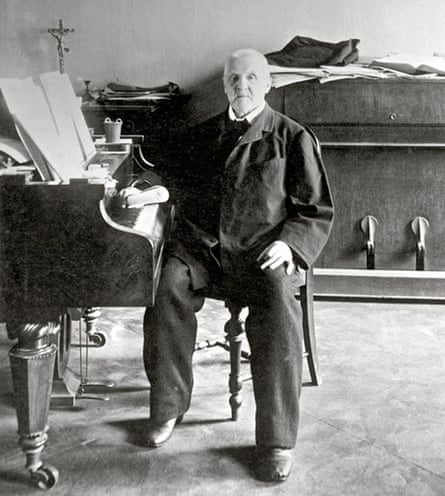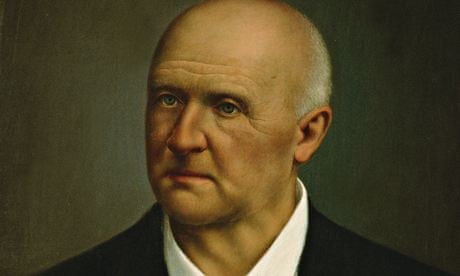A credulous yokel who propositioned girls half his age. A death-obsessed ghoul who kept a photo of his mother's corpse. A cranky, backwards-looking obsessive. The composer of some of the 19th century's greatest, grandest and most ambitious symphonies. Anton Bruckner was all of these things. One thing he wasn't, however, was a writer of beautiful music offering serene escapism.
Mariss Jansons and Amsterdam's Concertgebouw, who visit London's Barbican this week to perform three Bruckner symphonies, will unleash sounds of orchestral ugliness and visions of existential disturbance that will – that should – have you quaking in your seats.
These works – Bruckner's 4th, 7th and his unfinished 9th – opened up a new musical and spiritual terrain. The titanic shocks that these paradoxical pieces delivered were achieved by a man who worshipped the gods of musical conservatism at a time when the rules of composition were being dismantled by the likes of Gustav Mahler and Richard Strauss. Bruckner, by contrast, spent his life exploring musical principles that had been laid down centuries earlier – the laws of counterpoint, the way one musical voice interacts with another – which marked him out as a cranky weirdo in the context of the progressive artistic and intellectual scene of late 19th-century Vienna.
Vienna wasn't Bruckner's hometown. Born in the village of Ansfelden, he trained in St Florian, a monastery town that he didn't properly leave until his middle age, having spent his youth in a self-annihilating study of musical arcana and hours of lonely training in order to become one of the world's greatest organists. It was only in his 40s in Vienna that Bruckner felt confident enough to embark on the symphonic project that would sustain the rest of his musical life. But in doing so, he had to face the wrath of his critics, who called him everything from "a drunkard" to the composer of "symphonic boa-constrictors" (that one was Brahms). He also had to put up with caricatures of him as a devoutly, credulously Catholic country bumpkin who propositioned teenage girls in his old age, and who once tipped a conductor with cash for getting through a rehearsal of one of his symphonies.
Actually, both of those anecdotes are all too true. And as John Butt, professor of music at Glasgow University and a Bruckner devotee, told me, Bruckner really was – well, a bit of an oddball. In his diaries, he kept lists of the girls he fancied (usually in their late teens), he had a mania for counting the bricks and windows of buildings, and for counting the numbers of bars in his gargantuan orchestral scores, making sure their proportions were statistically correct. And there were even stranger sides to this kind of behaviour: when his mother died, Bruckner commissioned a photograph of her on her death bed and kept it in his teaching room. He had no image of his mother when she was alive, just this grotesque-seeming token of her death staring out at him as an unsettling memento mori. Butt also recalls accounts of Bruckner having "fingered and kissed the skulls of Beethoven and Schubert" when their corpses were exhumed and moved to a different cemetery; that Bruckner had requested permission to see the skull of a dead cousin (he was refused), and also that of the Emperor Maximilian, whose body was returned to Vienna after his execution in Mexico in 1867.

Bruckner: death-obsessed maniac. Well, partly. But as Butt says, "in the way that some obsessives don't get anywhere in life, others get there in a very quirky way". Bruckner's peculiar brand of musical obsessiveness produced visions of grandeur that are at once ancient and modern. You hear that in the opening of the 4th symphony's final, fourth movement – a chilling, dehumanised orchestral landscape in sound; in the emotional desolation of the 7th symphony's slow movement, a tribute to the recently dead Wagner; and throughout the three completed movements of the 9th.
For me, this is Bruckner's boldest compositional achievement. The symphony is the only one of his that's explicitly dedicated to God. In a sense all of Bruckner's music is a tribute to his devout faith, but the 9th dares something darker, more doubting, more apocalyptic, and more ear-shatteringly aggressive and even deliberately ugly than he had attempted before. The massively loud and dissonant orchestral pile-up of a chord near the end of the third movement is a vision of a despairing abyss that the quiet music that comes after it can't possibly console. It's as if Bruckner shrinks back from the vision his exquisitely arcane brain had led him to. That chord is the product of a passage of music that behaves entirely according to the laws of musical structure that the composer revered. Yet all that careful construction reveals something so strange, so shocking, and so disturbing – all the more so because the music has the irresistible power of a force of nature rather than a subjective, personal scream. It's a moment that's a transfiguration of all that obsessiveness. This isn't Bruckner's shout into the void, but the cosmos itself in pain. At least, that's what it sounds like to me; in the Concertgebouw's performance, it will confront the Barbican audience with violent sonic terrors. I hope that audience is ready.

Comments (…)
Sign in or create your Guardian account to join the discussion